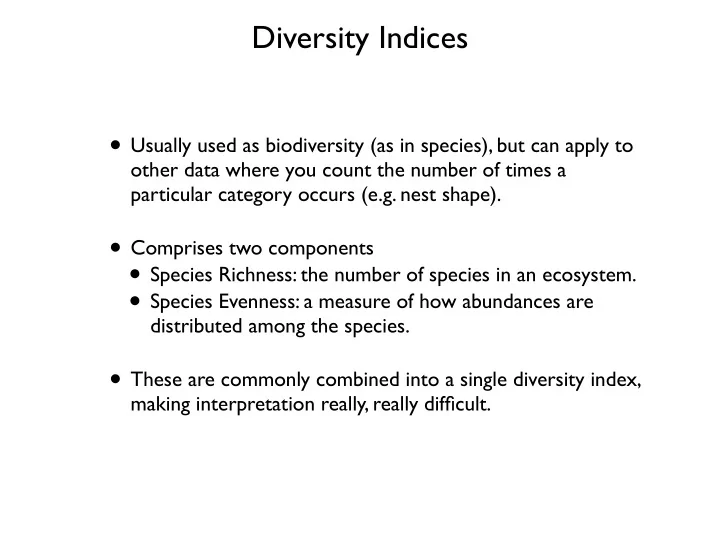

Diversity Indices • Usually used as biodiversity (as in species), but can apply to other data where you count the number of times a particular category occurs (e.g. nest shape). • Comprises two components • Species Richness: the number of species in an ecosystem. • Species Evenness: a measure of how abundances are distributed among the species. • These are commonly combined into a single diversity index, making interpretation really, really difficult.
Which sample is more diverse?
RNA Sequencing Study 700 600 Number of Unique Sequences 500 400 300 200 100 0 0 1000 2000 3000 4000 5000 6000 7000 8000 9000 10000 Total number of reads • Pyrosequencing reads thousands of genetic sequences from a sample • How many unique sequences are there? It depends on how many total sequences you count. • Number of species encountered in some way depends on the number of individuals counted.
Species Richness R 1 = S − 1 Margalef (1958) ( ) ln n n=number of individuals S= number of species R 2 = S Menhinick (1964) n These are based on some presumed relationship between S and n which may or may not hold for your case.
Species Richness A better way... Rarefaction Habitat N S 9 50 14 20 122 38 36 62 8 • Based on your actual data • Computes probabilities of encountering a species at n individuals.
1.8 Rarefaction Curve 1.7 Menhinick 1.6 10 1.5 1.4 9 1.3 Number of Species 1.2 8 1.1 2.1 1 2.05 0 10 20 30 40 50 60 70 80 7 2 1.95 6 1.9 Margalef 1.85 5 1.8 1.75 1.7 4 1.65 1.6 0 10 20 30 40 50 60 70 80 3 0 10 20 30 40 50 60 70 80 Sample Size
“Diversity” Indices Evenness and Richness Combined S ( ) n i n i − 1 ∑ Simpson’s index λ = ( ) n n − 1 i = 1 n i =number of individuals of species i n = total number of individuals counted S = total number of species S ⎡ ⎤ ⎛ ⎜ ⎞ ⎛ ⎜ ⎞ n i ln n i ∑ Shannon’s Index H = − ʹ″ ⎟ ⎟ ⎢ ⎥ n n ⎝ ⎠ ⎝ ⎠ ⎣ ⎦ i = 1
Evenness Indices H ʹ″ E 1 = Pielou (1975) a.k.a. J’ ln( S ) H ʹ″ E 2 = e Sheldon (1969) S H − 1 ʹ″ E 3 = e Heip (1974) S − 1 E 4 = 1/ λ Hill (1973) dominance → 1 H ʹ″ e ( ) − 1 E 5 = 1/ λ Alatalo (1981) dominance → 0 H − 1 ʹ″ e
But how different is different? Actual Shannon Diversity
1) download the Biodiversity File from the web site 2) for each sample (TET38, S3 and ARIES 46) calculate the following: a) Margalef and Menhinick species richness b) Shannon and Simpson diversity indices c) Hill’s evenness index
Recommend
More recommend